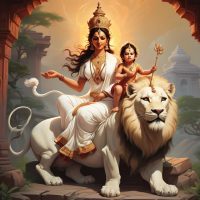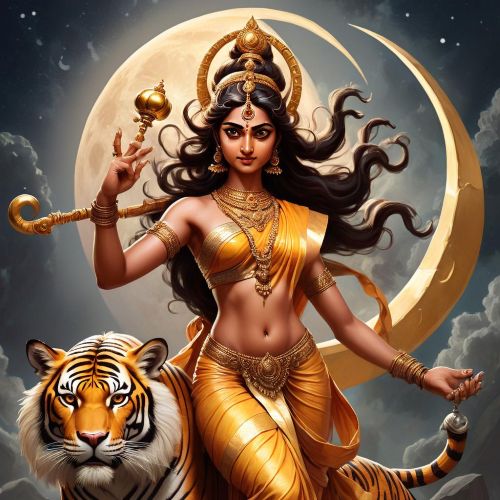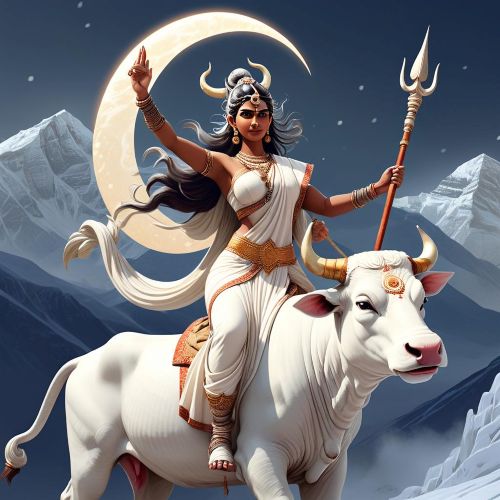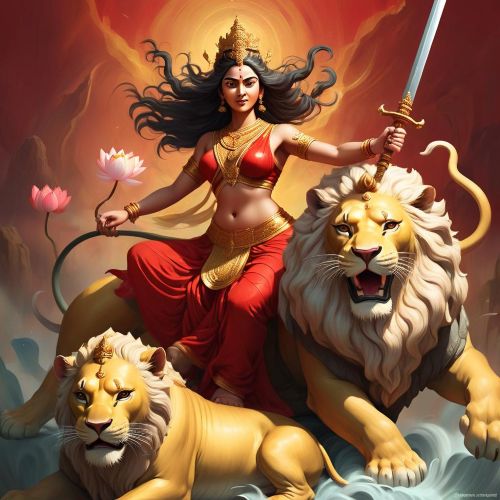Skandamata : Goddess of Compassion
Listen
At a glance
| Description | |
|---|---|
| Origin | Indian Mythology |
| Classification | Gods |
| Family Members | Shiva (Husband), Skanda (Son) |
| Region | India |
| Associated With | Compassion, Courage, War |
Skandamata
Introduction
Skandamata holds a special place in Hindu mythology as the fifth form of Goddess Durga, worshipped on the fifth day of Navratri. Her name literally means “Mother of Skanda,” referring to her son Kartikeya, the god of war. She represents the union of a mother’s nurturing essence and a protector’s courage, embodying both tenderness and strength. In devotional traditions, she is celebrated as a compassionate mother who grants wisdom, prosperity, and salvation to her devotees while fiercely protecting them from harm. Skandamata’s worship reflects the deep-rooted cultural reverence for motherhood and its role in upholding dharma.
Physical Traits
Skandamata is most commonly depicted with four arms. Two of her hands hold blooming lotus flowers, symbols of purity and spiritual awakening. With one right hand, she cradles her infant son Skanda, while the other hand is raised in Abhaya Mudra, a gesture that assures protection and blessings. She is often seated on a fully bloomed lotus, earning her the name Padmasana Devi. At times, she is also portrayed riding a lion, underscoring her fearlessness and power. Her serene face radiates compassion, while her posture reflects dignity and readiness to act. Descriptions of her appearance often highlight a bright, golden or white aura that conveys both divine warmth and spiritual authority.
Family
Skandamata is regarded as a form of Parvati, the divine consort of Lord Shiva. Together, they are parents to two prominent deities: Kartikeya, the commander of the celestial army, and Ganesha, the remover of obstacles. The mythology of Kartikeya’s birth is deeply significant. According to the Skanda Purana and other texts, Skanda was created to defeat the demon Tarakasura, whose destruction was prophesied to be possible only through Shiva’s offspring. The circumstances of Skanda’s birth are complex, with variations across texts, including mentions of Agni and Ganga playing roles in his arrival. Despite these diverse narratives, Parvati is universally recognized as Skanda’s mother, and her aspect as Skandamata highlights this maternal bond. Through her family connections, she represents the balance between divine asceticism (Shiva), wisdom (Ganesha), and valor (Kartikeya).
Other names
The name Skandamata directly translates to “Mother of Skanda,” but she is also known by other epithets. As Padmasana Devi, she is associated with the lotus seat that symbolizes purity and transcendence. Within the Navadurga tradition, she is revered as Navadurga Panchami Devi, the fifth manifestation honored during Navratri. Devotional hymns and mantras often invoke her through her 108 names, collectively known as the Ashtottara Shatanamavali. Each of these names emphasizes a distinct quality—her motherly nature, her strength, or her role as a spiritual guide. In southern traditions, where Kartikeya is more commonly called Murugan or Subramanya, Skandamata is sometimes addressed with titles that reflect regional reverence for her role as the divine mother.
Powers and Abilities
Skandamata’s powers extend beyond her role as the mother of a warrior god. She governs the Vishuddha Chakra, also known as the throat chakra, which is linked with communication, wisdom, and clarity of thought. Devotees believe that her blessings enhance intellectual abilities, refine speech, and promote spiritual understanding. As a mother figure, she offers unconditional protection, ensuring peace and harmony within families. Her influence is also said to temper the harsh effects of Saturn (Shani), bringing relief to those suffering under its astrological impact. Skandamata is known to remove negativity and fear, guiding her devotees toward salvation. She symbolizes the ideal blend of nurturing love and fierce defense of righteousness, granting courage to face challenges while fostering compassion and balance.
Modern Day Influence
In today’s world, the worship of Skandamata remains deeply significant, particularly during Navratri celebrations. On the fifth day, devotees offer her prayers with white flowers, fruits, and milk-based sweets, seeking her blessings for wisdom, prosperity, and spiritual strength. Her iconography is widely circulated in digital devotional art, temple murals, and educational resources that emphasize the enduring value of maternal divinity.
Beyond religious rituals, Skandamata’s symbolism resonates in broader cultural contexts. She embodies the ideal of empowered motherhood—compassionate yet courageous—an image that continues to inspire women and families. In India’s popular culture, films, plays, and devotional television shows often portray her as the protective goddess who nurtures and safeguards her children while standing firm against evil. Academic discussions on feminine divinity frequently cite Skandamata as an example of how Hindu mythology integrates maternal care with the safeguarding of cosmic order.
Astrologically, Skandamata is linked with Mercury (Budh), the planet associated with intellect and communication, reinforcing her role as a guide for clarity and learning. In regions like Bengal and Tamil Nadu, elaborate depictions of her form are included in temple art and seasonal festivals, highlighting her cultural and spiritual relevance. Even in modern spiritual discourse, she is invoked as a divine force guiding devotees through challenges with wisdom and maternal strength.
Related Images
Source
Dharmayug. (2025, April 6). Goddess Skandamata: Story, Symbolism, Puja Vidhi & Mantras. https://www.dharmayug.com/blogs/english/goddess-skandamata-the-mother-of-skanda-and-queen-of-compassion
Sanskriti Magazine. (n.d.). Navratri Series – Day 5: Goddess Skandamata – The Mother of Wisdom and Courage. https://www.sanskritimagazine.com/navratri-series-day-5-goddess-skandamata-the-mother-of-wisdom-and-courage/
Rudraksha Ratna. (n.d.). Skandamata Devi (Navratri 5th Day Goddess): Story, Significance, Beej Mantra & Colour. https://www.rudraksha-ratna.com/articles/skandamata-devi
Kinsley, D. R. (1988). Hindu Goddesses: Visions of the Divine Feminine in the Hindu Religious Tradition. University of California Press.
Foulston, L., & Abbott, S. (2009). Hindu Goddesses: Beliefs and Practices. Sussex Academic Press.
Brown, C. M. (1998). The Triumph of the Goddess: The Canonical Models and Theological Meanings of the Devi Mahatmya. SUNY Press.
Pattanaik, D. (2010). 7 Secrets of the Goddess. Westland Publications.
Dimmitt, C., & van Buitenen, J. A. B. (1978). Classical Hindu Mythology: A Reader in the Sanskrit Puranas. Temple University Press.
Frequently Asked Questions
What is lorem Ipsum?
I am text block. Click edit button to change this text. Lorem ipsum dolor sit amet, consectetur adipiscing elit. Ut elit tellus, luctus nec ullamcorper mattis, pulvinar dapibus leo.
What is lorem Ipsum?
I am text block. Click edit button to change this text. Lorem ipsum dolor sit amet, consectetur adipiscing elit. Ut elit tellus, luctus nec ullamcorper mattis, pulvinar dapibus leo.
What is lorem Ipsum?
I am text block. Click edit button to change this text. Lorem ipsum dolor sit amet, consectetur adipiscing elit. Ut elit tellus, luctus nec ullamcorper mattis, pulvinar dapibus leo.
What is lorem Ipsum?
I am text block. Click edit button to change this text. Lorem ipsum dolor sit amet, consectetur adipiscing elit. Ut elit tellus, luctus nec ullamcorper mattis, pulvinar dapibus leo.
What is lorem Ipsum?
I am text block. Click edit button to change this text. Lorem ipsum dolor sit amet, consectetur adipiscing elit. Ut elit tellus, luctus nec ullamcorper mattis, pulvinar dapibus leo.













